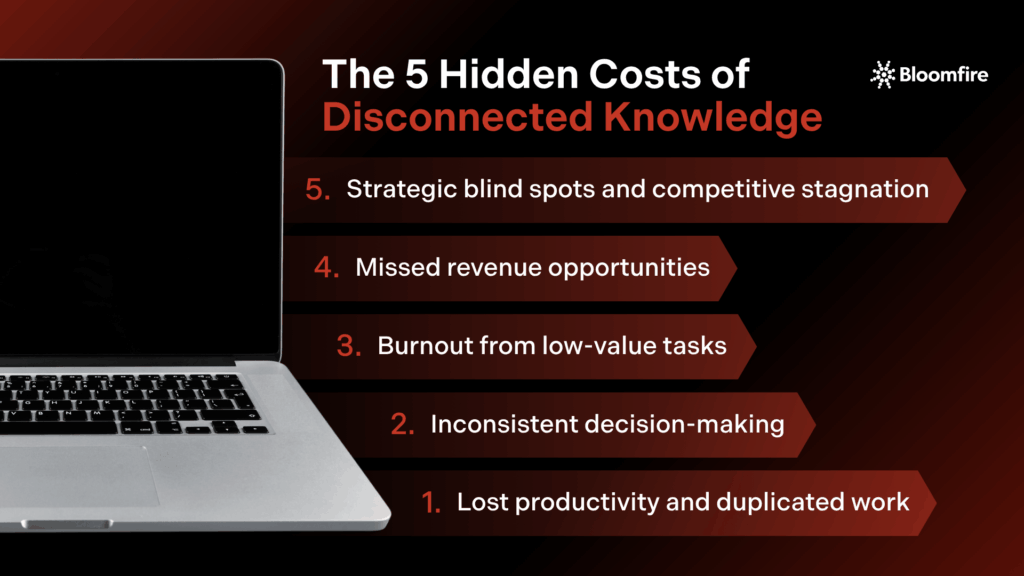The Hidden Cost of Disconnected Knowledge–And The Role of Enterprise Intelligence in Connecting Knowledge Pools

Companies possess valuable knowledge scattered across separate information silos. Many don’t realize how much this fragmentation costs them. Knowledge workers waste up to 30% of their time looking for information. Business inefficiency directly eats away 25% of annual revenue.
The impact of disconnected knowledge runs deep, leading to wasteful repetition, duplicate reports, repeated market analyses, and teams having to start from scratch unnecessarily. Smart companies don’t need more systems to integrate enterprise knowledge. They need better connections between existing ones. An intelligent enterprise framework that connects knowledge delivers impressive results.
The first step is connecting your organization’s knowledge pools effectively. Read on to discover the crucial part Enterprise Intelligence plays in connecting knowledge pools and how Bloomfire helps teams unify it, reducing friction and accelerating insight.
What Disconnected Knowledge Looks Like in Organizations
Fragmented knowledge has become an expensive hidden problem in today’s enterprises. Employees spend 21% of their work time looking for information. They waste another 14% recreating information they can’t find. This adds up to a full day each week lost to digital scavenger hunts.
For many organizations, these telltale signs of disconnected knowledge are:
- Scattered systems and siloed teams: A typical company’s knowledge setup looks like a digital maze. Today’s workers use about eight different SaaS apps each day. Companies typically maintain around 137 apps across their business. This explosion of platforms creates communication barriers that translate into unnecessary costs.
- Missed insights due to poor visibility: Companies adopt various systems as they grow without watching their data centrally. Important information is split across multiple locations, making it difficult to track. This divide creates hidden risks and missed opportunities that can throw off strategic decisions.
- Widespread duplication and compliance liability: When employees can’t easily find a unified, approved source of truth, they often save multiple copies of documents locally or in separate team drives. This consumes enormous storage space and creates compliance and version control nightmares.
Companies today use a mix of disconnected tools instead of treating knowledge as a single, connected system. This split gets pricey when departments, systems, and business units can’t share data properly, underscoring the need to connect knowledge pools..
The Hidden Costs of Disconnected Knowledge
Disconnected enterprise knowledge systems create problems that go way beyond simple inefficiency. Hidden costs slowly erode company performance, employee morale, and the competitive edge.
This silent drain is often mistaken for standard operational friction, but its impact is far more profound. When critical data, expertise, and documents are scattered across disparate systems. This constant need to search, verify, and reconcile information is the true weight of disconnected knowledge–and it manifests in the following forms:

1. Lost productivity and duplicated work
Your teams waste much of their workweek on tasks that add little value. They spend 3.6 hours managing internal communications, 2.8 hours looking for information, and 2.2 hours in pointless meetings each week.
The situation gets worse. Workers spend hours weekly redoing work that already exists somewhere in their organization. All but one of these workers reports spending more than six redundant hours each week on duplicate work. This waste happens because knowledge stays disconnected.
2. Inconsistent decision-making
Decision quality suffers when knowledge pools aren’t properly connected. Available information shapes our choices, and fragmented knowledge leads to incomplete information, leading to frustration and confusion.
Emotional states significantly impact the consistency of our decisions. This gap becomes more obvious when employees can’t access complete information. Decisions vary based on timing and who makes them. The problem arises when important data remains trapped in departmental silos, disrupting team coordination.
3. Burnout from low-value tasks
Low-value, repetitive tasks lead straight to employee burnout. An overwhelming 85% of workers say these tasks are the primary reason they experience burnout. These activities cause stress about four times every week—over 200 times per year.
The financial toll is enormous. Employee burnout costs companies between $4,000 and $21,000 per employee yearly. Companies with 1,000 employees lose around $5 million each year.
4. Missed revenue opportunities
Disconnected knowledge hits revenue potential hardest. Business inefficiency costs about 25% of yearly revenue. Fortune 500 companies with $9 billion in revenue lose $2.4 billion in enterprise value annually.
Revenue leaks through multiple channels. Marketing campaigns often face a 30% return rate due to poor data quality. Companies miss cross-selling opportunities. Critical insights remain unused as 68% of enterprise data never gets analyzed.
5. Strategic blind spots and competitive stagnation
Disconnected knowledge cripples your organization’s ability to see the bigger picture and react effectively to market shifts. When internal data is siloed and expertise is locked away in individual heads or departmental folders, the company loses its collective intelligence.
You can’t perform accurate foresight planning because you lack a unified view of past performance, current customer trends, and internal capabilities. This creates significant strategic blind spots. Competitors who can synthesize and act on their collective knowledge faster gain a decisive edge, leaving your organization to play catch-up.
Companies possess huge reserves of valuable knowledge that remain unused because they exist in silos. The first step to making knowledge integration work is to understand what constitutes company or enterprise knowledge.
What Actually Counts as Company Knowledge?
Eliminating disconnected knowledge hinges on the critical first step of understanding and defining what genuinely constitutes the company’s intellectual assets. These assets are far more than official documents; they encompass verified, current, and strategically valuable information and expertise that directly contribute to business objectives, innovation, and competitive advantage.
A company’s real knowledge base isn’t limited to a formal document repository. It’s a rich, dynamic tapestry that includes:
- Slack threads documenting critical decisions
- Comprehensive CRM notes detailing customer history
- In-depth project retrospectives capturing lessons learned
- Detailed field reports from frontline operations
- Crucial tribal knowledge (unwritten expertise of experienced employees)
Recognizing this broad scope is essential. When knowledge lives in these dispersed silos, decisions slow down significantly, and employees waste enormous amounts of time and energy recreating what already exists.
Companies that can’t effectively connect, centralize, and utilize this collective knowledge simply can’t scale it. Scaling requires consistency, efficiency, and the rapid transfer of best practices used in an environment that cultivates Enterprise Intelligence. All of these are impossible when institutional wisdom is fragmented or hidden.
3 Common Types of Enterprise Knowledge to Connect
Enterprise knowledge covers all information that drives your business operations—from documented procedures to customer insights and employee expertise. Most organizations create more information than they realize.
The average employee has access to around 10.8 million files. This vast volume presents an ideal opportunity for knowledge integration rather than expanding systems. First, however, it’s crucial to identify these types of enterprise knowledge to better plan their connection.
1. Structured Knowledge
Structured knowledge exists in predefined formats that make it easy to search and analyze. It has CRM records, support ticket data, survey results, and activities that measure best practices. These knowledge bases contain top-down requirements like manuals, directories, and newsletters. Structured information builds the backbone of organizational processes and provides consistent answers and standard procedures.
2. Unstructured Knowledge
Unstructured data lacks predefined formatting yet represents 90% of all enterprise-generated information. It has text documents, PDFs, social media posts, blogs, images, multimedia files, and content from Microsoft Teams or Slack.
Unlike structured data, unstructured information remains unused despite being diverse, flexible, and rich with insights. Organizations hold vast stores of unstructured data that could significantly improve AI model performance when used for training.
3. Tacit Knowledge
Tacit knowledge refers to expertise that’s difficult to articulate—the know-how gained through personal experience, observation, and interaction. It covers communication skills, cultural sensitivity, intuition, and knowing how to direct informal organizational norms.
Tribal knowledge, often unrecorded, is passed down through generations within specific teams and shapes the company culture. Team members understand this knowledge through unwritten norms and practices, though it’s not formally documented.
Why Enterprise Search Isn’t Enough Anymore
Companies invest heavily in search capabilities, yet their staff spends almost 2 hours each day searching for information across disconnected systems. The core problem is that while enterprise search is helpful, it is fundamentally reactive. It only helps users find what they know exists, missing hidden connections and unexpected learnings across the organization.
Enterprise search has built-in limitations. Results are returned based on simple keywords without a true understanding of context or intent, forcing employees to sift through mountains of irrelevant data. Search only works when systems index content perfectly and users know the exact right keywords—neither condition is reliably met in real-world work situations.
Furthermore, the collaborative nature of modern knowledge work creates another challenge: an employee’s search discoveries often remain isolated, rather than benefiting the entire organization. Team members often end up redundantly searching for and finding the same information.
Better search isn’t the answer—connected knowledge is. The principles of Enterprise Intelligence demand more than simple retrieval; it requires understanding. It moves beyond simple keyword matching by linking information across all systems. These frameworks don’t treat documents as isolated units; they connect related concepts, spot patterns, and build a complete context around information.
This is where connection logic comes into play. Bloomfire, for example, helps teams apply this logic by bringing together insights, conversations, and documents in one unified knowledge network. It connects both structured and unstructured knowledge across platforms before employees even ask a question. Teams can access an intelligent network where information comes to them, instead of endlessly searching through separate tools.
How to Connect Knowledge Pools Through Enterprise Intelligence
Converting scattered information into Enterprise Intelligence needs a methodical approach that goes beyond regular search tools. This transformation, achieved through effective enterprise knowledge integration, doesn’t require new repositories or extra software. It focuses instead on building smart integrations between existing knowledge assets by connecting knowledge pools through the following steps:

Step 1: Access it
Acquiring distributed knowledge begins with establishing connection pathways. For instance, with Bloomfire, you can use API-based connectors to extract valuable information from isolated systems without disrupting their current work.
These knowledge connectors bring unstructured business data into central frameworks. Organizations can pull specific documents from custom data sources without syncing entire systems. Financial services companies can keep their knowledge bases current with the latest market data. This ensures that their applications provide users with relevant information.
Step 2: Normalize it
Knowledge needs to be standardized once it becomes available. Data normalization organizes information so it appears similar across disciplines and records. This makes finding, grouping, and analyzing easier.
The process removes extraneous and unstructured elements to create a logical data storage structure. Good standardization covers formatting, naming rules, and categorization. It creates consistency in structure and the types of data captured. Organizations improve their data quality, accuracy, and reliability this way. These elements are the foundations of solid decision-making.
Step 3: Contextualize it
Adding context brings meaning to normalized information. The semantic layer helps understand context by capturing relationships and domain-specific knowledge within content. Semantic tagging and entity extraction enrich information with metadata that describes context, topics, and entities.
Auto-tagging helps apply relevant keyword tags to data. This makes large datasets more organized and available. Users can interpret and analyze content in meaningful ways when they understand the context in which it is presented. This leads to deeper insights and better decisions.
Typical Platforms Housing Fragmented Knowledge
Modern enterprises struggle with knowledge scattered across disconnected platforms. Most organizations use a mix of systems instead of a unified knowledge ecosystem. This fragmentation forces employees to hunt for critical information across disparate tools, wasting time and hindering decision-making.
- Collaboration platforms: Messages and communications are split between platforms such as Slack and Microsoft Teams. Employees waste time switching between apps while messages stay isolated. This leads to duplicate work and broken communication chains that hurt productivity.
- Repositories: Document storage systems store vital information in isolation. SharePoint provides teams with web-based intranets and document management capabilities, but it also has disadvantages that require additional apps. Google Drive provides 15GB of free storage. Many organizations use both systems at once. This creates duplicate files and version control issues, leaving gaps in knowledge.
- Operational tools: Customer platforms hold valuable data but don’t share it effectively. Zendesk and HubSpot collect unique data on customer interactions. To name just one example, see how support tickets in Zendesk stay disconnected from sales opportunities in Salesforce. This creates blind spots in customer understanding.
- Email & Notes: Team documentation tools trap vital context in silos. Notion gives teams flexible workspaces to organize content and tasks. Confluence provides structured documentation for enterprises. The biggest problem is that knowledge in these platforms rarely connects with other systems.
- Legacy systems: Old systems, such as file servers, often hold irreplaceable data. Legacy intranets grew from informal, unsanctioned roots. It can lead to scattered communication and high maintenance costs. Employees now wade through outdated information to find what they need.
The cost of fragmented knowledge is measured in wasted time and missed opportunities. But these effects can be avoided if you unify these platforms and begin connecting knowledge pools in a system that champions Enterprise Intelligence.
How Bloomfire Supports the Shift Toward Enterprise Intelligence
Bloomfire leads the Enterprise Intelligence revolution by doing much more than storing company information. Unlike traditional knowledge management systems, Bloomfire intelligently connects isolated information sources and turns scattered data into actionable information. It transforms disparate, reactive data retrieval into proactive, context-aware insight generation through the following methods:
1. The API revamp
The API framework connects knowledge seamlessly. Companies can now pull information from systems of all types without disrupting their existing processes. Developers use the platform’s REST-based API architecture to build custom integrations. These integrations extract content from isolated repositories, making knowledge accessible throughout the organization. Teams keep using their preferred tools while Bloomfire quietly connects information in the background.
2. The ingestion connectors
Bloomfire’s pre-built knowledge connectors do more than just basic API integration. They automatically import content from common enterprise applications, enabling seamless integration of enterprise knowledge. Smart monitoring systems continuously track source systems.
New or updated content is automatically added to the knowledge network. The platform efficiently processes a wide range of file formats, from traditional documents to multimedia files. It maintains version control and applies consistent metadata across all sources.
3. The metadata automation
Industry experts note that nearly half of digital workers struggle to locate the data they need. This issue arises because traditional manual metadata processes struggle to keep pace with modern data environments.
Bloomfire’s metadata automation addresses this problem by capturing information from various sources and providing it in a structured format. The process starts with extracting and normalizing content. It ensures clean, consistent data formats that AI applications can use. Automated tools then transform unstructured text into standardized formats that machine learning models and analytics workflows can process.
With Bloomfire, teams gain instant access to contextualized insights, not just isolated documents. The platform enables organizations to move toward the different levels of Enterprise Intelligence by connecting fragmented knowledge pools into a single network of shared understanding.
Connection Is the First Step Toward Enterprise Intelligence
Many companies struggle with knowledge scattered across multiple, disconnected repositories, leading to inconsistent or delayed answers. Enterprise Intelligence, made actionable by Bloomfire, solves this not by adding new systems but by linking existing ones. It begins with a knowledge connection that turns scattered expertise into a unified knowledge network, allowing insights to flow naturally across traditional boundaries and enabling better decisions at scale.
End Disconnected Knowledge
Time to unify your Enterprise Intelligence. Turn connected data into an advantage.
Learn More

Enterprise AI Search: Definition, Benefits, and Evolution

The Benefit of Company-Wide Knowledge Management in 2026

Are You Making These Common Knowledge Sharing Mistakes?

Estimate the Value of Your Knowledge Assets
Use this calculator to see how enterprise intelligence can impact your bottom line. Choose areas of focus, and see tailored calculations that will give you a tangible ROI.

Take a self guided Tour
See Bloomfire in action across several potential configurations. Imagine the potential of your team when they stop searching and start finding critical knowledge.
